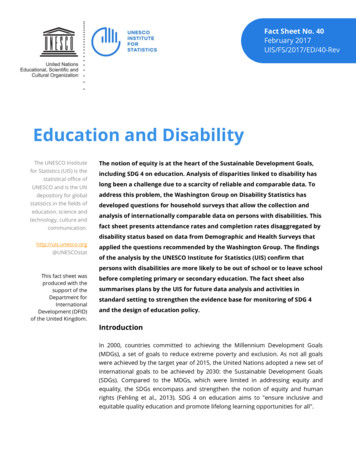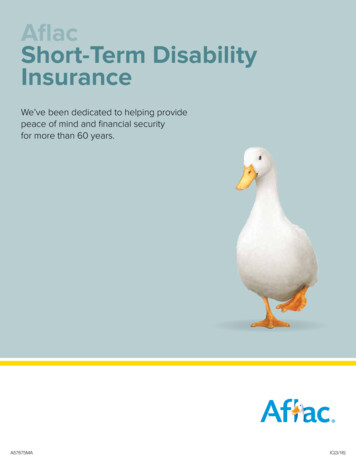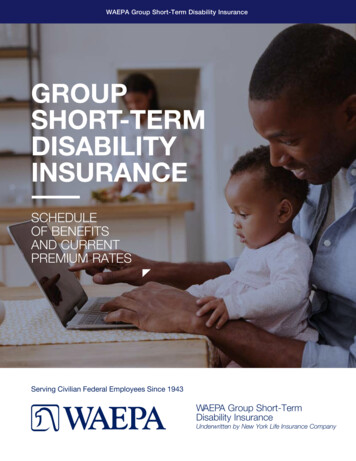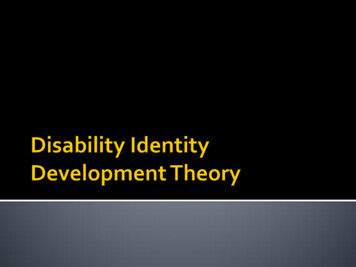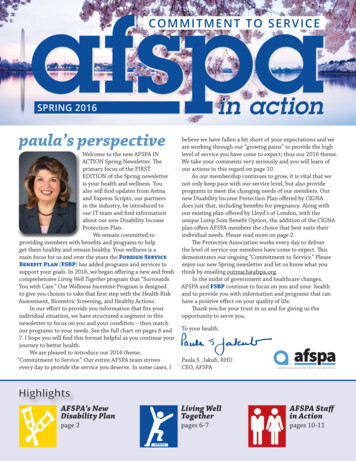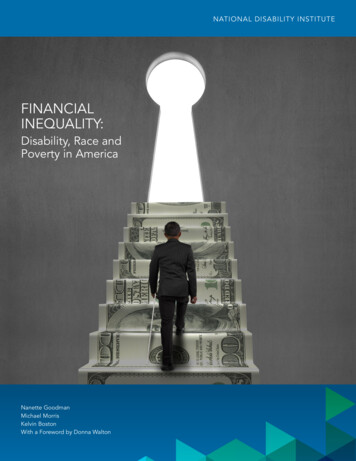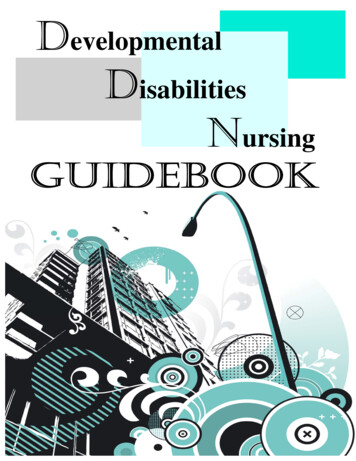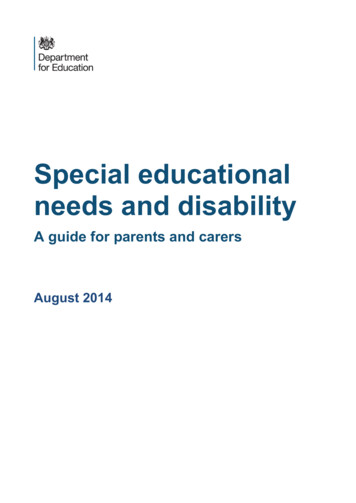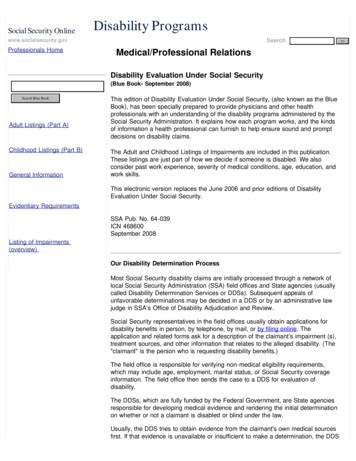
Transcription
e t noco t p i kSSocial Security OnlineDisability Programswww.socialsecurity.govProfessionals HomeSearchMedical/Professional RelationsDisability Evaluation Under Social Security(Blue Book- September 2008)Search Blue BookAdult Listings (Part A)Childhood Listings (Part B)General InformationThis edition of Disability Evaluation Under Social Security, (also known as the BlueBook), has been specially prepared to provide physicians and other healthprofessionals with an understanding of the disability programs administered by theSocial Security Administration. It explains how each program works, and the kindsof information a health professional can furnish to help ensure sound and promptdecisions on disability claims.The Adult and Childhood Listings of Impairments are included in this publication.These listings are just part of how we decide if someone is disabled. We alsoconsider past work experience, severity of medical conditions, age, education, andwork skills.This electronic version replaces the June 2006 and prior editions of DisabilityEvaluation Under Social Security.Evidentiary RequirementsSSA Pub. No. 64-039ICN 468600September 2008Listing of Impairments(overview)Our Disability Determination ProcessMost Social Security disability claims are initially processed through a network oflocal Social Security Administration (SSA) field offices and State agencies (usuallycalled Disability Determination Services or DDSs). Subsequent appeals ofunfavorable determinations may be decided in a DDS or by an administrative lawjudge in SSA’s Office of Disability Adjudication and Review.Social Security representatives in the field offices usually obtain applications fordisability benefits in person, by telephone, by mail, or by filing online. Theapplication and related forms ask for a description of the claimant’s impairment (s),treatment sources, and other information that relates to the alleged disability. (The"claimant" is the person who is requesting disability benefits.)The field office is responsible for verifying non-medical eligibility requirements,which may include age, employment, marital status, or Social Security coverageinformation. The field office then sends the case to a DDS for evaluation ofdisability.The DDSs, which are fully funded by the Federal Government, are State agenciesresponsible for developing medical evidence and rendering the initial determinationon whether or not a claimant is disabled or blind under the law.Usually, the DDS tries to obtain evidence from the claimant's own medical sourcesfirst. If that evidence is unavailable or insufficient to make a determination, the DDSGO
will arrange for a consultative examination (CE) to obtain the additional informationneeded. The claimant's treating source is the preferred source for the CE, but theDDS may obtain the CE from an independent source. After completing itsdevelopment of the evidence, trained staff at the DDS makes the initial disabilitydetermination.Then, the DDS returns the case to the field office for appropriate action. If the DDSfound that the claimant is disabled, SSA completes any outstanding non-disabilitydevelopment, computes the benefit amount, and begins paying benefits. If theclaimant was found not to be disabled, the file is kept in the field office in case theclaimant decides to appeal the determination.Back to TopPrivacy Policy Website Policies & Other Important Information Site MapLast reviewed or modified Wednesday Feb 09, 2011NeedLarger Text?
e t noco t p i kSSocial Security OnlineDisability Programswww.socialsecurity.govProfessionals HomeSearchGOMedical/Professional RelationsDisability Evaluation Under Social Security(Blue Book- September 2008)Search Blue BookPart I - General InformationProgram DescriptionAdult Listings (Part A)Childhood Listings (Part B)General InformationThe Social Security Administration (SSA) administers two programs that providebenefits based on disability: the Social Security disability insurance program (title IIof the Social Security Act (the Act)) and the supplemental security income (SSI)program (title XVI of the Act).Title II provides for payment of disability benefits to individuals who are "insured"under the Act by virtue of their contributions to the Social Security trust fund throughthe Social Security tax on their earnings, as well as to certain disabled dependentsof insured individuals. Title XVI provides for SSI payments to individuals (includingchildren under age 18) who are disabled and have limited income and resources.Evidentiary RequirementsThe Act and SSA's implementing regulations prescribe rules for deciding if anindividual is "disabled." SSA's criteria for deciding if someone is disabled are notnecessarily the same as the criteria applied in other Government and privatedisability programs.Listing of Impairments(overview)Definition of DisabilityFor all individuals applying for disability benefits under title II, and for adults applyingunder title XVI, the definition of disability is the same. The law defines disability asthe inability to engage in any substantial gainful activity (SGA) by reason of anymedically determinable physical or mental impairment(s) which can be expected toresult in death or which has lasted or can be expected to last for a continuousperiod of not less than 12 months.Disability in ChildrenUnder title XVI, a child under age 18 will be considered disabled if he or she has amedically determinable physical or mental impairment or combination ofimpairments that causes marked and severe functional limitations, and that can beexpected to cause death or that has lasted or can be expected to last for acontinuous period of not less than 12 months.What is a "Medically Determinable Impairment"?A medically determinable physical or mental impairment is an impairment thatresults from anatomical, physiological, or psychological abnormalities which can beshown by medically acceptable clinical and laboratory diagnostic techniques. Aphysical or mental impairment must be established by medical evidence consistingof signs, symptoms, and laboratory findings-not only by the individual's statement ofsymptoms.The Disability Determination Process
Most disability claims are initially processed through a network of local SocialSecurity field offices and State agencies (usually called disability determinationservices, or DDSs). Subsequent appeals of unfavorable determinations may bedecided in the DDSs or by administrative law judges in SSA's Office of DisabilityAdjudication and Review.Social Security Field OfficesSSA representatives in the field offices usually obtain applications for disabilitybenefits, either in person, by telephone, by mail, or via an online application process.The application and related forms ask for a description of the claimant'simpairment(s); names, addresses, and telephone numbers of treatment sources;and other information that relates to the alleged disability. (The "claimant" is theperson who is requesting disability benefits.)The field office is responsible for verifying nonmedical eligibility requirements, whichmay include age, employment, marital status, citizenship/residency and SocialSecurity coverage information, and additionally, for SSI eligibility, income, resources,and living arrangement information. The field office sends the case to a DDS forevaluation of disability.State Disability Determination ServicesThe DDSs, which are fully funded by the Federal Government, are State agenciesresponsible for developing medical evidence and rendering the initial determinationon whether the claimant is or is not disabled or blind under the law.Usually, the DDS tries to obtain evidence from the claimant's own medical sourcesfirst. If that evidence is unavailable or insufficient to make a determination, the DDSwill arrange for a consultative examination (CE) in order to obtain the additionalinformation needed. The claimant's treating source is the preferred source for theCE; however, the DDS may also obtain the CE from an independent source. (SeePart II, Evidentiary Requirements, for more information about CEs.)After completing its initial development, the DDS makes the disability determination.The determination is made by a two-person adjudicative team consisting of amedical or psychological consultant and a disability examiner. If the adjudicativeteam finds that additional evidence is still needed, the consultant or examiner mayrecontact a medical source(s) and ask for supplemental information.The DDS also makes a determination whether the claimant is a candidate forvocational rehabilitation (VR). If so, the DDS makes a referral to the State VRagency.After the DDS makes the disability determination, it returns the case to the fieldoffice for appropriate action depending on whether the claim is allowed or denied. Ifthe DDS finds the claimant disabled, SSA will complete any outstanding nondisability development, compute the benefit amount, and begin paying benefits. Ifthe claimant is found not disabled, the file is retained in the field office in case theclaimant decides to appeal the determination.If the claimant files an appeal of an initial unfavorable determination, the appeal isusually handled much the same as the initial claim, except that the disabilitydetermination is made by a different adjudicative team in the DDS than the one thathandled the original case.Office of Disability Adjudication and ReviewClaimants dissatisfied with the first appeal of a determination may file subsequent
appeals. The second appeal is processed by a hearing office within ODAR. Anadministrative law judge makes the second appeal decision, usually afterconducting a hearing and receiving any additional evidence from the claimant'smedical sources or other sources.ODAR frequently conducts medical development through the DDS. However,hearing offices may also contact medical sources directly. In rare circumstances, anadministrative law judge may issue a subpoena requiring production of evidence ortestimony at a hearing.Back to TopThe Role of the Health ProfessionalHealth professionals play a vital role in the disability determination process andparticipate in the process in a variety of ways:As treating sources or other medical sources who provide medical evidenceon behalf of their patients;As CE sources to perform, for a fee, examinations and/or tests that areneeded;As full-time or part-time medical or psychological consultants reviewingclaims in a DDS, in one of SSA's regional offices, or in SSA central office; orAs medical experts who testify at administrative law judge hearings orrespond to written interrogatories from the administrative law judge.Treating SourcesA treating source is a claimant's own physician, psychologist, or other acceptablemedical source who has provided the claimant with medical treatment or evaluationand has or has had an ongoing treatment relationship with the claimant. Thetreating source is usually the best source of medical evidence about the nature andseverity of an individual's impairment(s).If an additional examination or testing is needed, SSA usually considers a treatingsource to be the preferred source for performing the examination or test for his orher own patient.The treating source is neither asked nor expected to decide whether the claimant isdisabled. However, a treating source will usually be asked to provide a statementabout an adult claimant's ability, despite his or her impairments, to do work‑relatedphysical or mental activities or a child’s functional limitations compared to childrenthe same age who do not have impairments.Consultative Examiners for the DDSIn the absence of sufficient medical evidence from a claimant's own medicalsources, SSA, through the State DDS, may request an additional examination(s).These CEs are performed by licensed physicians (medical or osteopathicphysicians), psychologists or, in certain circumstances, other health professionalssuch as optometrists, podiatrists, and speech-language pathologists. All CE sourcesmust be currently licensed in the State and have the training and experience toperform the type of examination or test SSA requests.Fees for CEs are set by each State and may vary from State to State. Each State
agency is responsible for comprehensive oversight management of its CE program.Medical professionals who perform CEs must have a good understanding of SSA'sdisability programs and their evidentiary requirements. In addition, these medicalprofessionals are made fully aware of their responsibilities and obligations regardingconfidentiality and:CE scheduling intervals;CE report content;Elements of a complete CE;When a complete CE is not required; andSignature requirements.See Part II of this guide for more information about CEs.Program Medical ProfessionalsPhysicians of virtually all specialties, psychologists and speech-languagepathologists at the State, regional, or national levels review claims for disabilitybenefits. The review work is performed in the State DDSs or SSA’s regional officesor headquarters. It is strictly a case review in which the program physician,psychologist or speech-language pathologist usually has no contact with theclaimant.Medical ExpertsBecause there is no direct involvement of medical professionals in the disabilitydecisions made by administrative law judges in ODAR, administrative law judgessometimes request expert testimony on complex medical issues. Each hearing officemaintains a roster of medical experts who are called to testify as expert witnesses athearings or respond to written interrogatories. The experts are paid a fee for theirservices.Confidentiality of RecordsTwo separate laws, the Freedom of Information Act and the Privacy Act, havespecial significance for Federal agencies. Under the Freedom of Information Act,Federal agencies are required to provide the public with access to their files andrecords. This means the public has the right, with certain exceptions, to examinerecords pertaining to the functions, procedures, final opinions, and policy of theseFederal agencies.The Privacy Act permits an individual or his or her authorized representative toexamine records pertaining to him or her in a Federal agency. For disabilityapplicants, this means that an individual may request to see the medical or otherevidence used to evaluate his or her application for disability benefits under theSocial Security or the SSI programs. (This evidence, however, is not available to thegeneral public.)SSA screens all requests to see medical evidence in a claim file to determine ifrelease of the evidence directly to the individual might have an adverse effect onthat individual. If so, the report will be released only to an authorized representativedesignated by the individual.
Back to TopQuestions and Answers About Social Security Disability ProgramsThis information is designed to provide a more thorough understanding of thedisability programs administered by SSA. Following are some of the most frequentquestions asked about these programs.Q. Who can get disability benefits under Social Security?A. Under the Social Security disability insurance program (title II of the Act), thereare three basic categories of individuals who can qualify for benefits on the basis ofdisability:A disabled insured worker under full retirement age.An individual disabled since childhood (before age 22) who is a dependent ofa parent entitled to title II disability or retirement benefits or was a dependentof a deceased insured parent.disabled widow or widower, age 50-60 if the deceased spouse was insuredunder Social Security.Under title XVI, or SSI, there are two basic categories under which a financiallyneedy person can get payments based on disability:An adult age 18 or over who is disabled.child (under age 18) who is disabled.Q. How is the disability determination made?A. SSA’s regulations provide for disability evaluation under a procedure known asthe "sequential evaluation process." For adults, this process requires sequentialreview of the claimant's current work activity, the severity of his or herimpairment(s), a determination of whether his or her impairment(s) meets ormedically equals a listing (see Part III of this guide), the claimant's residualfunctional capacity, his or her past work, and his or her age, education, and workexperience. For children applying for SSI, the process requires sequential review ofthe child's current work activity (if any), the severity of his or her impairment(s), andan assessment of whether his or her impairment(s) results in marked and severefunctional limitations. If an adult or child is found disabled or not disabled at anypoint in the evaluation, the evaluation does not continue.Q. When do disability benefits start?A. Disability benefits for workers and widows usually cannot begin for 5 monthsafter the established onset of the disability. Therefore, Social Security disabilitybenefits will be paid for the sixth full month after the date the disability began. The5-month waiting period does not apply to individuals filing as children of workers.Under SSI, disability payments may begin as early as the first full month after theindividual applied or became eligible for SSI.In addition, under the SSI disability program, an applicant may be found"presumptively disabled or blind," and receive cash payments for up to 6 monthswhile the formal disability determination is made. The presumptive payment isdesigned to allow a needy individual to meet his or her basic living expenses during
the time it takes to process the application. If it is finally determined that theindividual is not disabled, he or she is not required to refund the payments. There isno provision for a finding of presumptive disability or blindness under the Title IIprogram.Q. What can an individual do if he or she disagrees with the determination?A. If an individual disagrees with the initial determination in the case, he or she mayappeal it. The first administrative appeal is a reconsideration, which is generally acase review at the State level by an adjudicative team that was not involved in theoriginal determination. If dissatisfied with the reconsideration determination, theindividual may request a hearing before an administrative law judge. If he or she isdissatisfied with the hearing decision, the final administrative appeal is for review bythe Appeals Council. In general, a claimant has 60 days to appeal an unfavorabledetermination or decision. Appeals must be filed in writing and may be submitted bymail or in person to any Social Security office.If the individual exhausts all administrative appeals, but wishes to continue pursuingthe case, he or she may file a civil suit in Federal District Court and eventuallyappeal all the way to the United States Supreme Court.Q. Can individuals receiving disability benefits or payments get Medicare orMedicaid coverage?A.Medicare helps pay hospital and doctor bills of disabled or retired people whohave worked long enough under Social Security to be insured for Social Securitybenefits. It generally covers people who are 65 and over; people who have beendetermined to be disabled and have been receiving benefits for at least 24 monthsor have amyotrophic lateral sclerosis; and people who need long‑term dialysistreatment for chronic kidney disease or require a kidney transplant. In general,Medicare pays 80 percent of reasonable charges.In most States, individuals who qualify for SSI disability payments also qualify forMedicaid. The Medicaid program is referred to by different names depending on theState. The program covers all of the approved charges of the Medicaid patient.Medicaid is financed by Federal and State matching funds, but eligibility rules mayvary from State to State.Q. Can someone work and still receive disability benefits?A. Social Security rules make it possible for people to test their ability to workwithout losing their rights to cash benefits and Medicare or Medicaid. These rulesare called "work incentives." The rules are different for title II and title XVI, but underboth programs they may provide:continued cash benefits;continued help with medical bills;help with work expenses or;vocational training.For more information about work incentives, ask anySocial Security Office for the a publication entitled the"Red Book," A Summary Guide to Employment Support forIndividuals with Disabilities under the Social SecurityDisability Insurance and Supplemental Security IncomePrograms. You can access the Red Book online at:
A Pub. No. 64-039ICN 468600September 2008Back to TopPrivacy Policy Website Policies & Other Important Information Site MapLast reviewed or modified Wednesday Feb 09, 2011NeedLarger Text?
e t noco t p i kSSocial Security OnlineDisability Programswww.socialsecurity.govProfessionals HomeSearchGOMedical/Professional RelationsDisability Evaluation Under Social Security(Blue Book- September 2008)Search Blue BookPart II - Evidentiary RequirementsMedical EvidenceAdult Listings (Part A)Under both the Title II and Title XVI programs, medical evidence is the cornerstonefor the determination of disability.Childhood Listings (Part B)Each person who files a disability claim is responsible for providing medicalevidence showing he or she has an impairment(s) and the severity of theimpairment(s). However, the Social Security Administration (SSA), with theclaimant’s permission, will help the claimant get medical reports from his or her ownmedical sources. This medical evidence generally comes from sources that havetreated or evaluated the claimant for his or her impairment(s).General InformationAcceptable Medical SourcesEvidentiary RequirementsListing of Impairments(overview)Documentation of the existence of a claimant's impairment must come from medicalprofessionals defined by SSA regulations as "acceptable medical sources." Oncethe existence of an impairment is established, all the medical and non-medicalevidence is considered in assessing impairment severity.Acceptable medical sources are:licensed physicians (medical or osteopathic doctors);licensed or certified psychologists including school psychologists (and otherlicensed or certified individuals with other titles who perform the samefunction as school psychologists in a school setting) only for purposes ofestablishing mental retardation, learning disabilities, and borderline intellectualfunctioning ;licensed optometrists only for purposes of establishing visual disorders(except in the U.S. Virgin Islands where licensed optometrists are acceptablemedical sources only for the measurement of visual acuity and visual fields);licensed podiatrists only for purposes of establishing impairments of the foot,or foot and the ankle, depending on whether the State in which the podiatristpractices permits the practice of podiatry on the foot only, or the foot and theankle; andqualified speech-language pathologists only for purposes of establishingspeech or language impairments. For this source, “qualified” means that thespeech-language pathologist must be licensed by the State education agencyin the State in which he or she practices, or hold a Certificate of ClinicalCompetence from the American Speech-Language-Hearing Association.Medical Evidence from Treating Sources
Currently, many disability claims are decided based on medical evidence fromtreating sources. SSA regulations place special emphasis on evidence from treatingsources because they are likely to be the medical professionals most able toprovide a detailed longitudinal picture of the claimant's impairment(s) and may bringa unique perspective to the medical evidence that cannot be obtained from themedical findings alone or from reports of individual examinations or briefhospitalizations. Therefore, timely, accurate, and adequate medical reports fromtreating sources accelerate the processing of the claim because they can greatlyreduce or eliminate the need for additional medical evidence to complete the claim.Medical Evidence From Health FacilitiesSSA also requests copies of medical evidence from hospitals, clinics, or otherhealth facilities where a claimant has been treated. All medical reports received areconsidered during the disability determination process.Other EvidenceInformation from other sources may also help show the extent to which anindividual's impairment(s) affects his or her ability to function in a work setting; or inthe case of a child, the ability to function compared to that of children the same agewho do not have impairments. Other sources include public and private agencies,non‑medical sources such as schools, parents and caregivers, social workers andemployers, and other practitioners such as naturopaths, chiropractors, andaudiologists.Medical ReportsPhysicians, psychologists, and other health professionals are frequently asked bySSA to submit reports about an individual's impairment(s). Therefore, it is importantto know what evidence SSA needs. Medical reports should include:medical history;clinical findings (such as the results of physical or mental statusexaminations);laboratory findings (such as blood pressure, x-rays);diagnosis;treatment prescribed with response and prognosis;a statement about what the claimant can still do despite his or herimpairment(s), based on the medical source's findings on the above factors.if the claimant is an adult age 18 or over, this statement should describe, butis not limited to, the claimant's ability to perform work-related activities, suchas sitting, standing, walking, lifting, carrying, handling objects, hearing,speaking, and traveling.in adult cases involving mental impairments or mental functional limitations,this statement should describe the claimant's capacity to understand, to carryout and remember instructions, and to respond appropriately to supervision,coworkers, and work pressures in a work setting.if the claimant is a child under age 18, this statement should describe the child’sfunctional limitations compared to children his or her age who do not haveimpairments in acquiring and using information, attending and completing tasks,interacting and relating with others, moving about and manipulating objects, caringfor yourself, and health and physical well-being.
Back to TopConsultative ExaminationsIf the evidence provided by the claimant's own medical sources is inadequate todetermine if he or she is disabled, additional medical information may be sought byrecontacting the treating source for additional information or clarification, or byarranging for a consultative examination (CE). The treating source is the preferredsource for a CE if he or she is qualified, equipped, and willing to perform theexamination for the authorized fee. Even if only a supplemental test is required, thetreating source is ordinarily the preferred source for this service. However, SSA’srules provide for using an independent source (other than the treating source) for aCE or diagnostic study if:the treating source prefers not to perform the examination;the treating source does not have the equipment to provide the specific dataneeded;there are conflicts or inconsistencies in the file that cannot be resolved bygoing back to the treating source;the claimant prefers another source and has good reason for doing so; orwe know from prior experience that the treating source may not be aproductive source.Consultative Examination Report ContentA complete CE report will involve all the elements of a standard examination in theapplicable medical specialty and should include the following elements:the claimant's major or chief complaint(s);a detailed description, within the area of specialty of the examination, of thehistory of the major complaint(s);a description, and disposition, of pertinent "positive" and "negative" detailedfindings based on the history, examination, and laboratory tests related to themajor complaint(s), and any other abnormalities or lack thereof reported orfound during examination or laboratory testing;results of laboratory and other tests (for example, X-rays) performedaccording to the requirements stated in the Listing of Impairments (see PartIII of this guide);the diagnosis and prognosis for the claimant's impairment(s);a statement about what the claimant can still do despite his or herimpairment(s), unless the claim is based on statutory blindness.if the claimant is an adult age 18 or over, this statement shoulddescribe the opinion of the consultant about the claimant's ability,despite his or her impairment(s), to do work-related activities, such assitting, standing, walking, lifting, carrying, handling objects, hearing,speaking, and traveling;in adult cases involving mental impairment(s) or mental functionallimitations, this statement should also describe the opinion of theconsultant about the claimant’s capacity to understand, to carry out andremember instructions, and to respond appropriately to supervision,
coworkers, and work pressures in a work setting.if the claimant is a child under age 18, this statement should describethe opinion of the consultant about the child's functional limitationscompared to children his or her age who do not have impairments inacquiring and using information, attending and completing tasks,interacting and relating with others, moving about and manipulatingobjects, caring for yourself, and heath and physical well-being.the consultant 's consideration, and some explanation or comment on, theclaimant's major complaint(s) and any other abnormalities found during thehistory and examination or reported from the laboratory tests. The history,examination, evaluation of laboratory test results, and the conclusions willrepresent the information provided by the consultant who signs the report.Evidence Relating to SymptomsIn developing evidence of the effects of sy
(Blue Book- September 2008) This edition of Disability Evaluation Under Social Security, (also known as the Blue. Book), has been specially prepared to provide physicians and other health. professionals with an understanding of the disability programs administered by the. Social Security Administration. It explains how each program works, and .
